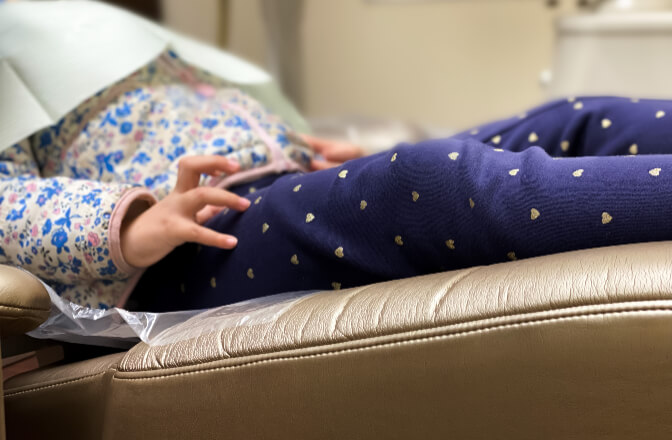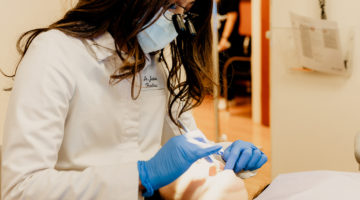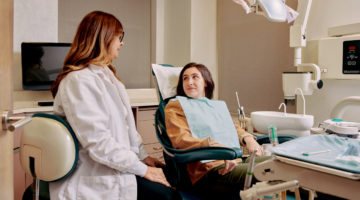While the lifetime value of a dental patient cannot be understated, you’ll sometimes encounter a difficult patient and need to work through it for both the health of the person and your practice. If you were wondering how to deal with sensitive patients and improve patient satisfaction, one, very direct way, is to address their dental fears. Dental fear, anxiety, or phobia are real entities that patients face, and dental practitioners must deal with daily. In the authoritative psychiatric handbook, Diagnostic and Statistical Manual of Mental Disorders (DSM) IV, a phobia is defined as “Marked and persistent fear that is excessive or unreasonable, cued by the presence or anticipation of a specific object or situation.” The operative phrase is “cued by the presence of anticipation.” The “cued anticipation” to some is the thought of sitting in the dentist’s chair and the overall experience of being treated for oral health.
In the study “Why Are People Afraid of the Dentist?” the researchers discovered that “the causes of dental fear, dental anxiety or dental phobia are related to exogenous factors such as direct learning from traumatic experiences, vicarious learning through significant others and the media.” This malady affects approximately “36% of the population, with a further 12% suffering from extreme dental fear.”
To understand it better, a Dandy contributor developed a short questionnaire and distributed it on social media. Respondents gave the following answers about how they feel regarding their dental experiences and what frightens them most.
6 most common dental dreads that patients experience
After aggregating and examining the respondents’ answers, there was an overarching theme—fear. Patients named the sources and described the types of fear they suffered. As they did, it was apparent that their distress was real to them and a deterrent from seeking dental help.
Fear of pain
One of the highest percentages of participants, over 25%, feared pain. Many related that pain kept them from going to the dentist based on previous experiences. That aligns with the study mentioned above, where the patient was hurt in the dental chair and anticipated being harmed again.
Over 25% of patients feared pain
One respondent stated that she feared “That the tooth isn’t numb and they start drilling. I had it happen. It’s always a white-knuckle moment.” Another respondent echoed this story. This individual said the situation occurred more than once.
“Dental is its own category of awful. Now, [because of the incident] I ask for two needles on most procedures.”
“Needles!” one person exclaimed. “I hate them.” On the subject of needles, many respondents expressed an intense panic at the sight of one. More than one participant shared how the feeling of the “long cold needle” entering the gum was something they never wanted to experience again. It is the reason why many avoid dentists. This avoidance begets a “vicious cycle of anxiety.” When it comes to dental anxiety management, it’s best for your patient not to see the needles.
In the study, Cognitive Behavior Therapy for Dental Phobia and Anxiety, the authors examined why and how fear influences a patient’s psychological, physiological, and social aspects of their lives. Accordingly, these drivers have a profound effect in creating the “vicious cycle of anxiety.” This cycle begins with the initial fear and anxiety and morphs into avoidance of treatment.
With time and continued lack of treatment, there is a deterioration of dental status, and oral health is affected negatively. The progression of such things as periodontal disease contributes to “issues of inferiority, shame and embarrassment” and more fear of judgment by the dental professional. Combined, these further lead to social aversion at work, with family, and in daily life. “This pattern of effects may lead to higher and more widespread anxiety of dentistry and eventually less regular dental care or even avoidance of dental treatment.”
Strategies for helping patients through their fear of pain
A good source for helping patients cope with anxiety is the book “Cognitive Behaviour Therapy for Dental Phobia and Anxiety.” The chapter “One-Session Treatment of Dental Phobia” provides excellent guidance on handling a patient with extreme anxiety.
- First, interview the patient before their dental appointment to ascertain how the phobia affects them. Ask questions like “When do you believe this fear started.” By revealing the development of the overwhelming fear, you may have insight into how to deal with it.
- If necessary, administer a questionnaire, such as the “Needle Phobia Followup Questionnaire,” to pinpoint the level of fear they suffer.
- Emphasize that you and the patient are a team that needs to work together to accomplish a goal. Review their case with them. A good intraoral scanner can provide detailed scans of the area and can relieve the patient’s fear of the unknown.
- Utilize topical numbing gel before any injections. Then, take your time to ensure that the Novocaine is working correctly before beginning any work. Ask them repeatedly about their level of numbness.
- Check that the tooth to be drilled in and the surrounding gum are correctly anesthetized.
- Before the dental procedure, demonstrate some of the utensils (such as an intraoral scanner) even allow your patient to acclimate to the feel of it in their mouth before beginning/.
- Talk calmly and slowly about other things to distract them as you inject. Another distraction is music or a television on the wall, which helps provide focus on something different than what is happening to them.
- If they raise a hand or indicate pain, respond positively to their warning and administer more Novocaine if necessary. Consider another type of anesthetic if needed.
While some these steps may seem like extra work, you have a relationship with your patient that may be undoing all their previous experiences. Instead, think of them as extra precautions. By providing a “safe space” for them to experience and see all you will do for them, you ensure that trust grows and they stay your patient. If you need to, find a therapist in your area who treats extreme dental phobia to whom you can refer patients.
Fear of Novocaine and its effects
While it is not pain, numbness can certainly be unsettling to many. Several people described how they experienced adverse side effects from the anesthetic. Symptoms such as heart palpitations, shaking, and even mirror pain at the injection site are not uncommon. One person admitted to having sensitivity to Novocaine and more numbness than expected. Then, there was the fear of the needle hitting a nerve—again. The fear of the Novocaine either not working or working too well was enough to keep people out of the dental office.
A strategy for dealing with this issue is, first, to be honest with the patient. Explain all the possible side effects, emphasizing that these are temporary. However, some members of the population do not do well with Novocaine. Healthline states, “About 1 in every 5,000 people has a genetic condition that makes them unable to break down (hydrolyze) Novocaine and similar medications. This condition is called pseudocholinesterase deficiency. It’s more common in certain populations, including the Persian Jewish community and Alaska Natives. People with this deficiency are more sensitive to Novocaine, and its effects may last much longer.”
Though Novocaine may last several hours, patients will eventually metabolize the anesthetic, and the symptoms will subside. Do your research on the patient. Discuss familial and past reactions to Novocaine and find out what you both may face.
Fear of medical costs
The highest percentage of participants feared incurring costs they could not afford. One respondent shared, “I’m not afraid of the possible pain, any of the dental work or procedures. I’m only afraid of what it will cost if they find something.”
This concern is not unreasonable. Currently, there are over 77 million people who have no dental health insurance at all. Additionally, according to a report by CNBC, 100 million people are in medical debt, ranging from under $500 (16%) to $10,000 or more (12%). It is no wonder that so many people are concerned.
100 million people are in medical debt
—CNBC
There is also the issue of having dental insurance that has limited coverage. One participant expressed great exasperation over insurance. “I am in the process of getting an implant,” she said, “but my dental insurance decided they wouldn’t cover anything but $70 of it. So maybe it’s more the frustration of why dental insurance companies cover things the way they do.”
As a recession seemingly looms in the future, one must ask if people will choose to avoid debt and save their funds for other things “deemed” a necessity over dental care, especially with limited insurance or total lack of coverage.
To mitigate this situation:
- Have your front office staff sit with your patient.
- Present all costs in writing.
- Supply possible financing or payment plans.
- Allow the patient to decide without undue influence.
Fear of unforeseen or more needed dental procedures
Another issue is closely related to financial costs and healthcare debt. The long time between dental visits often exacerbates a patient’s negative dental health. When they finally find their way into a dental office, they are faced with more care required than anticipated.
An individual said he was afraid of “going in for a cleaning and the dentist finding something else that will cost a lot—not getting it done because I can’t afford yet another bill. Or offering a service that I’m sure would be helpful but having to say no because it’s not covered. But feeling pressured to do it anyway.”
Interestingly, 20% of participants were scared of being diagnosed with a more significant dental issue, such as a cavity or root canal, than what they were seeking help for initially. Still, it was interesting to hear that many were equally concerned about the pressure for case acceptance.
Fear of the pressure of case acceptance
Several of those who answered the questionnaire voiced concern over the pressure for case acceptance. People saw case acceptance merely as a “moneymaker.” More than one respondent revealed how they lacked trust in their dental care provider.
“I don’t trust they have my best interests at heart,” one individual divulged. “I’ve had quite a few dentists that have made questionable recommendations. Including services I didn’t really need or performed a procedure without giving me the full scope of potential consequences.”
Another individual discussed not feeling “validated” by her doctor, which caused her to leave the practice and find another dentist.
These responses reveal a lack of relationship-building on the part of the dentist. Trust must be the primary objective if you want your patient to return. Take the time with each patient to understand their needs and wants. Though, accepting them is often complicated. After all, time is the proxy for money. But without patient retention strategies in place, you will spend more money on acquiring new patients than keeping existing ones. The choice is obvious. Building trusting relationships help build a solid patient base.
Overwhelmed by the overall experience
Death by 1,000 prods.
When your patients come to your office, you are not only providing them with services. You are selling them an experience. If that patient experience is less than satisfying, they will find a replacement.
“The smell. The cost. The pain. All of it.” It is incredible how our environments trigger physiological, emotional, and psychological responses. Smells and sounds can bring back memories and set a tone for the present experience. If that seems an issue for your patients, consider making changes to your office.
In our article How to Improve the Patient Experience in a Dental Office, it is suggested “to make your practice more visually appealing, opt for less sterile decor, allow plenty of natural light, and rethink your uniforms. To address the sound aspect, you can play soft music and ensure no sounds from the clinic area reach reception. For the smells, you could use a scent diffuser or an air freshener.”
Additionally, a few people shared a feeling of claustrophobia when dental staff were “up in their grill.” The closeness of proximity and aversion of people in their personal space triggers some people. This can be solved by discussing the subject and making special consolations, such as small breaks during treatment, to give the patient some “breathing space.”
From the people you hire to the colors on your walls, the music you play, and even the cleaning solvents used, everything contributes to the overall experience. Make it a pleasurable one.
The good news
Not all of what was discovered was negative. Some participants expressed the joy of going to the dentist because of positive experiences since childhood. Others shared that going to the dentist was like “a reset every six months.” The dental hygienist experience was like “magic to make me feel so much better.”
Another was insightful about modern dentistry. “Modern dentistry is great! Your dentist is your friend who can save you from a world of pain, but like with any friend, it can take some time to find true friends. We are lucky in this day and age.”
Your dentist is your friend who can save you from a world of pain, but like with any friend, it can take some time to find true friends.
The appeal of modern dentistry was evident and sought out. People desire cutting-edge new dental technology that saves time, effort, and pain. Many stated that it’s surprising that there haven’t been more technological advancements in dentistry. That means modern digital dentists need to raise their profiles and presence.
Patients will respond to the difference between what was termed as the “old days” style of dentistry, including modern digital dentistry tools. Intraoral scanners (like those in our services) are revelatory and beneficial for providing the patient with transparency to understand what they are facing and how to cope with it. There is something to the phrase “seeing is believing,” and it calms fear and anxiety. And that is the best part of the patient retention motion.



